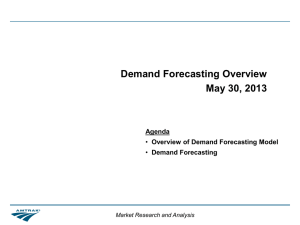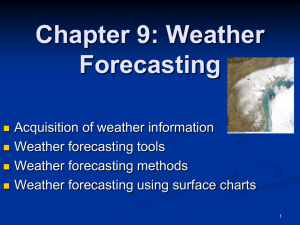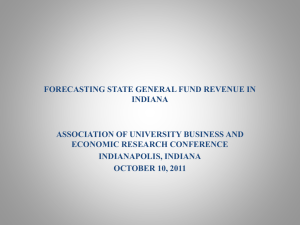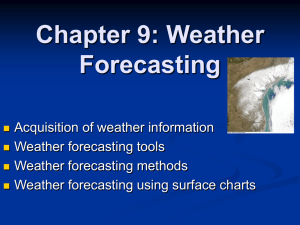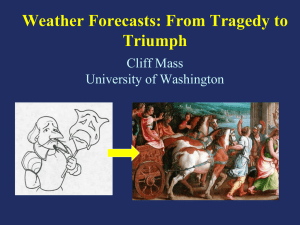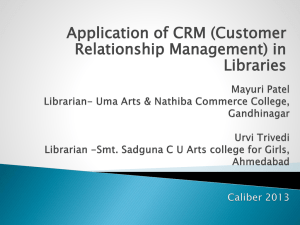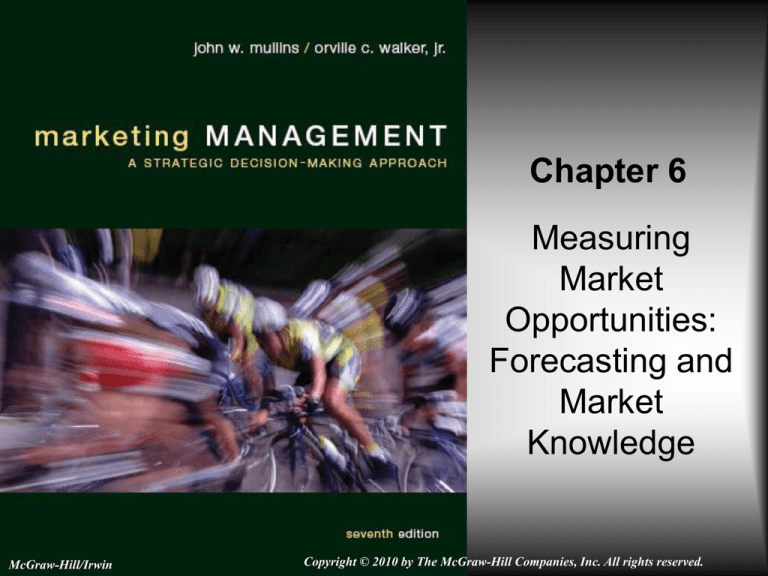
Chapter 6
Measuring
Market
Opportunities:
Forecasting and
Market
Knowledge
McGraw-Hill/Irwin
Copyright © 2010 by The McGraw-Hill Companies, Inc. All rights reserved.
Every forecast is wrong!
• The future is inherently uncertain,
especially in today’s rapidly changing
markets.
• An evidence-based forecast, instead of a
wild guess, is almost always called for,
even if time and money are scarce.
6-2
A Forecaster’s Toolkit
• An estimate of market potential often
serves as a starting point for preparing a
sales forecast.
• The size of the currently penetrated
market should also be ascertained.
• Investors will also need a sales forecast.
6-3
A Forecaster’s Toolkit
• Two broad approaches for preparing a
sales forecast:
– Top-down approach in which a central person
or persons take the responsibility for
forecasting and prepare an overall forecast.
– Bottom-up approach in which each part of the
firm prepares its own sales forecast, and the
parts are aggregated to create the forecast for
the firm as a whole
6-4
A Forecaster’s Toolkit
• Statistical methods
– These use past history and various statistical
techniques, such as multiple regression or
time series analysis, to forecast the future.
– These generally assume that the future will
look very much like the past.
– Sometimes this is not the case.
6-5
A Forecaster’s Toolkit
• Other quantitative methods:
– Methods to mathematically model the
diffusion of innovation process for consumer
durables.
– Conjoint analysis, a method to forecast the
impact on consumer demand of different
combinations of attributes that might be
included in a new product.
6-6
A Forecaster’s Toolkit
• Observation
– Attractive method because it is based on what
people actually do.
• Surveys or focus groups
• Analogy
– The product is compared with similar
historical data that are available.
– Also used for new-to-the-world hightechnology products
6-7
A Forecaster’s Toolkit
• Judgment
– Sometimes forecasts are made solely on the
basis of experienced judgment, or intuition.
– Defending such forecasts against those
prepared by evidence-based methods is
difficult.
• Mathematics entailed in forecasting
– The chain ratio calculation.
– The use of indices.
6-8
A Forecaster’s Toolkit
• Market tests
– May be done under controlled experimental
conditions in research laboratories, or in live
test markets.
– Use of live test markets has declined for two
reasons:
• They are expensive to conduct.
• Competitors can buy the data collected through
scanners at the checkout and learn the results of
the test market without bearing the expense.
6-9
Rate of Diffusion of Innovations
• Diffusion of innovation theory seeks to
explain the adoption of an innovative
product or service over time among a
group of potential buyers.
• The adoption process involves the
attitudinal changes experienced by
individuals from the time they first hear
about a new product, service, or idea until
they adopt it.
6-10
Rate of Diffusion of Innovations
• Speed of adoption depends on:
– The risk.
– The relative advantage over other products.
– The relative simplicity of the new product.
– Its compatibility with previously adopted
ideas.
– The extent to which its trial can be
accomplished on a small-scale basis.
– The ease with which the central idea of the
new product can be communicated.
6-11
Diffusion of Innovation Curve
6-12
Rate of Diffusion of Innovations
• Implications of diffusion of innovation
theory
– A good way to estimate how quickly an
innovation is likely to move through the
diffusion process is to construct a chart that
rates the adoption on the six key factors
influencing adoption speed.
– Introducing a new product that delivers no
real benefits or lacks competitive advantage is
likely to face tough sledding.
6-13
Cautions and Caveats in Forecasting
• Keys to good forecasting
– Making explicit the assumptions on which the
forecast is based.
– Using multiple methods.
6-14
Cautions and Caveats in Forecasting
• Common sources of error in forecasting
– Forecasters are subject to anchoring bias.
– Capacity constraints are sometimes
misinterpreted as forecasts.
– Incentive pay.
– Instated but implicit assumptions can
overstate a well-intentioned forecast.
6-15
Why Data?
Why Marketing Research?
• Without adequate market knowledge,
marketing decisions are likely to be
misguided.
• Thoughtfully designed, competently
executed marketing research can mitigate
the chances of unpleasant outcomes.
6-16
Customer Relationship Management
and Market Knowledge Systems
• Four market knowledge systems:
– Internal records regarding marketing
performance
– Marketing databases
– Competitive intelligence systems
– Systems to organize client contact
• Taken together, these lie at the heart of the
systematic practice of customer
relationship management (CRM).
6-17
Customer Relationship Management
and Market Knowledge Systems
• Internal records systems
– Internal records systems help track what is
selling, how fast, in which locations, to which
customers, and so on.
– Providing input on the design of such systems
so that the right data are provided to the right
people at the right time is a critical marketing
responsibility in any company.
6-18
Customer Relationship Management
and Market Knowledge Systems
• The purpose of CRM is to develop a
unified and cohesive view of the customer
from every touch point within the company.
– Databases created for CRM purposes
typically capture information about::
•
•
•
•
Transactions
Instances of customer contact
Customer demographics
Customer responses
6-19
Customer Relationship Management
and Market Knowledge Systems
• Database design considerations:
– The cost of collecting the data.
– The economic benefits of using the data.
– The ability of the company to keep the data
current in today’s mobile society.
– The rapid advances in technology.
• Data mining
6-20
Customer Relationship Management
and Market Knowledge Systems
• Implementing an effective CRM effort
requires four key steps:
– Gaining broad-based organizational support
for creating and adopting a CRM strategy.
– Forming a cross-functional CRM team with
membership from all functions that have
customer contact.
– Conducting a needs analysis that identifies
both customer and business needs.
– Developing a CRM strategy to guide
implementation.
6-21
Customer Relationship Management
and Market Knowledge Systems
• Major pitfalls to watch out for:
– Implementing CRM without first developing a
strategy.
– Putting CRM in place without changing
organizational structure and/or processes.
– Assuming that more CRM is better.
– Failure to prioritize which customer
relationships are most worth investing in.
6-22
Customer Relationship Management
and Market Knowledge Systems
• Client contact systems
– Salesforce automation software helps
companies disseminate real-time product
information to salespeople.
• Competitive intelligence systems
– A systematic and ethical approach for
gathering and analyzing information about
competitors’ activities and related business
trends.
– It is based on the idea that more than 80
percent of all information is public knowledge.
6-23
Marketing Research: A Foundation for
Marketing Decision Making
• Marketing research task is the design,
collection, analysis, and reporting of
research intended to gather data pertinent
to a particular marketing challenge or
situation.
6-24
Marketing Research: A Foundation for
Marketing Decision Making
• Step 1: Identify the managerial problem
and establish research objectives
– A good place to start is to ask what the
managerial problem or question is that a
proposed program of research might address.
– Taking each of the managerial questions and
applying appropriate analytical frameworks to
each of them results in a set of research
objectives that will drive the research.
6-25
Marketing Research: A Foundation for
Marketing Decision Making
• Step 2: Determine the data sources and
types of data required
– Primary or secondary sources?
– Qualitative or quantitative data and research
approaches?
• Step 3: Design the research
– Determine the data collection method and
prepare the research instrument.
– Determine the contact method.
– Design the sampling plan.
6-26
Marketing Research: A Foundation for
Marketing Decision Making
• Step 4: Collect the data
– Contributes more to overall error than any
other step.
– Collector bias.
• Step 5: Analyze the data
– Often, sophisticated statistical analyses are
required.
• Step 6: Report the results to the decision
maker
6-27
What Users of Marketing Research
Should Ask?
• Questions:
– What are the objectives of the research? Will the data
to be collected meet those objectives?
– Are the data sources appropriate? Is cheaper, faster
secondary data used where possible? Is qualitative
research planned to ensure that quantitative
research, if any, is on target?
– Are the planned approaches suited to the objectives
of the research?
– Is the research designed well?
– Are the planned analyses appropriate?
6-28
Take-Aways
• Every forecast and estimate of market
potential is wrong!
– Evidence-based forecasts and estimates,
prepared using the tools provided in this
chapter, are far more credible—and generally
more accurate—than hunches or wild
guesses.
6-29
Take-Aways
• Forecasts have powerful influence on what
companies do, through budgets and other
planning procedures.
• Superior market knowledge is not only an
important source of competitive
advantage, but it also results in happier,
higher volume of, and more loyal
customers.
6-30
Take-Aways
• Much can go wrong in marketing research
and often does.
– Becoming an informed and critical user of
marketing research is an essential skill for
anyone who seeks to contribute to strategic
decision making.
6-31


